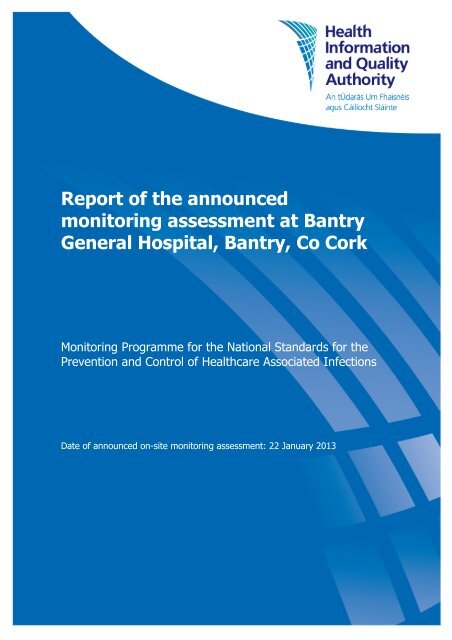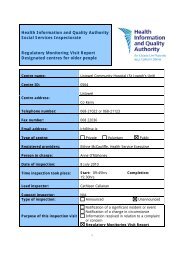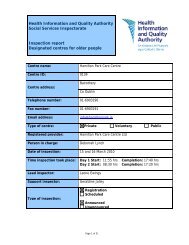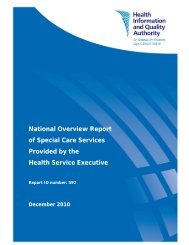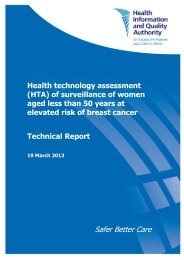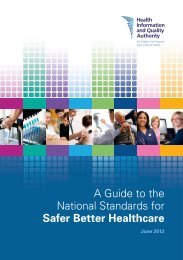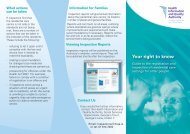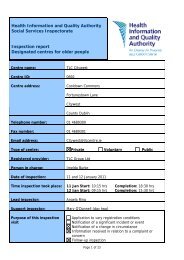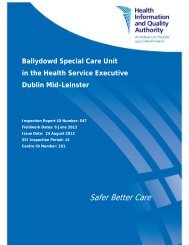Report of the announced monitoring assessment at Bantry ... - hiqa.ie
Report of the announced monitoring assessment at Bantry ... - hiqa.ie
Report of the announced monitoring assessment at Bantry ... - hiqa.ie
You also want an ePaper? Increase the reach of your titles
YUMPU automatically turns print PDFs into web optimized ePapers that Google loves.
<strong>Report</strong> <strong>of</strong> <strong>the</strong> <strong>announced</strong> <strong>monitoring</strong> <strong>assessment</strong> <strong>at</strong> <strong>Bantry</strong> General Hospital, CorkHealth Inform<strong>at</strong>ion and Quality Authority<strong>Report</strong> <strong>of</strong> <strong>the</strong> <strong>announced</strong><strong>monitoring</strong> <strong>assessment</strong> <strong>at</strong> <strong>Bantry</strong>General Hospital, <strong>Bantry</strong>, Co CorkMonitoring Programme for <strong>the</strong> N<strong>at</strong>ional Standards for <strong>the</strong>Prevention and Control <strong>of</strong> Healthcare Associ<strong>at</strong>ed InfectionsD<strong>at</strong>e <strong>of</strong> <strong>announced</strong> on-site <strong>monitoring</strong> <strong>assessment</strong>: 22 January 2013i
<strong>Report</strong> <strong>of</strong> <strong>the</strong> <strong>announced</strong> <strong>monitoring</strong> <strong>assessment</strong> <strong>at</strong> <strong>Bantry</strong> General Hospital, CorkHealth Inform<strong>at</strong>ion and Quality AuthorityAbout <strong>the</strong> Health Inform<strong>at</strong>ion and Quality AuthorityThe Health Inform<strong>at</strong>ion and Quality Authority (HIQA) is <strong>the</strong> independent Authorityestablished to drive continuous improvement in Ireland’s health and personal socialcare services, monitor <strong>the</strong> safety and quality <strong>of</strong> <strong>the</strong>se services and promote personcentredcare for <strong>the</strong> benefit <strong>of</strong> <strong>the</strong> public.The Authority’s mand<strong>at</strong>e to d<strong>at</strong>e extends across <strong>the</strong> quality and safety <strong>of</strong> <strong>the</strong> public,priv<strong>at</strong>e (within its social care function) and voluntary sectors. <strong>Report</strong>ing to <strong>the</strong>Minister for Health and <strong>the</strong> Minister for Children and Youth Affairs, <strong>the</strong> HealthInform<strong>at</strong>ion and Quality Authority has st<strong>at</strong>utory responsibility for: Setting Standards for Health and Social Services – Developing personcentredstandards, based on evidence and best intern<strong>at</strong>ional practice, for thosehealth and social care services in Ireland th<strong>at</strong> by law are required to be regul<strong>at</strong>edby <strong>the</strong> Authority. Social Services Inspector<strong>at</strong>e – Registering and inspecting residential centresfor dependent people and inspecting children detention schools, foster careservices and child protection services. Monitoring Healthcare Quality and Safety – Monitoring <strong>the</strong> quality andsafety <strong>of</strong> health and personal social care services and investig<strong>at</strong>ing as necessaryserious concerns about <strong>the</strong> health and welfare <strong>of</strong> people who use <strong>the</strong>se services. Health Technology Assessment – Ensuring <strong>the</strong> best outcome for people whouse our health services and best use <strong>of</strong> resources by evalu<strong>at</strong>ing <strong>the</strong> clinical andcost effectiveness <strong>of</strong> drugs, equipment, diagnostic techniques and healthpromotion activit<strong>ie</strong>s. Health Inform<strong>at</strong>ion – Advising on <strong>the</strong> effic<strong>ie</strong>nt and secure collection andsharing <strong>of</strong> health inform<strong>at</strong>ion, evalu<strong>at</strong>ing inform<strong>at</strong>ion resources and publishinginform<strong>at</strong>ion about <strong>the</strong> delivery and performance <strong>of</strong> Ireland’s health and socialcare services.ii
Table <strong>of</strong> Contents<strong>Report</strong> <strong>of</strong> <strong>the</strong> <strong>announced</strong> <strong>monitoring</strong> <strong>assessment</strong> <strong>at</strong> <strong>Bantry</strong> General Hospital, CorkHealth Inform<strong>at</strong>ion and Quality Authority1. Background ................................................................................................. 21.1. Essential elements for safe, high quality care ........................................................... 32. Overv<strong>ie</strong>w ..................................................................................................... 32.1. <strong>Bantry</strong> General Hospital ................................................................................................ 33. Findings ...................................................................................................... 43.1. Risks identif<strong>ie</strong>d ............................................................................................................... 43.2. Theme 1: Leadership, Governance and Management ............................................. 53.3. Theme 2: Workforce ..................................................................................................... 83.4. Theme 3: Safe Care ...................................................................................................... 94. Overall Conclusion ....................................................................................... 184.1. Overv<strong>ie</strong>w ....................................................................................................................... 185. Recommend<strong>at</strong>ions ....................................................................................... 20Appendix 1 – Themes and Essential Elements .......................................................... 211
<strong>Report</strong> <strong>of</strong> <strong>the</strong> <strong>announced</strong> <strong>monitoring</strong> <strong>assessment</strong> <strong>at</strong> <strong>Bantry</strong> General Hospital, CorkHealth Inform<strong>at</strong>ion and Quality Authority1. BackgroundThe Health Inform<strong>at</strong>ion and Quality Authority (<strong>the</strong> Authority) has <strong>the</strong> n<strong>at</strong>ionalst<strong>at</strong>utory role ± for developing standards for <strong>the</strong> quality and safety <strong>of</strong> healthcareservices. The N<strong>at</strong>ional Standards for <strong>the</strong> Prevention and Control <strong>of</strong> HealthcareAssoci<strong>at</strong>ed Infections (NSPCHCAI) were approved by <strong>the</strong> Minister for Health andChildren on 26 May 2009. Under <strong>the</strong> Health Act 2007, <strong>the</strong> Authority has <strong>the</strong> st<strong>at</strong>utoryresponsibility, amongst o<strong>the</strong>r functions, for <strong>monitoring</strong> compliance with N<strong>at</strong>ionalStandards and advising <strong>the</strong> Minister for Health as to <strong>the</strong> level <strong>of</strong> compliance.The NSPCHCAI provide a framework for health and social care providers to preventor minimise <strong>the</strong> occurrence <strong>of</strong> Healthcare Associ<strong>at</strong>ed Infections (HCAIs) in order tomaximise <strong>the</strong> safety and quality <strong>of</strong> care delivered to all health and social carep<strong>at</strong><strong>ie</strong>nts in Ireland. The NSPCHCAI aim to drive a culture <strong>of</strong> responsibility andaccountability among all staff involved in <strong>the</strong> management and delivery <strong>of</strong> healthand social care services – all <strong>of</strong> whom must play <strong>the</strong>ir part in preventing andcontrolling HCAIs. While services may differ in terms <strong>of</strong> scale, service-userpopul<strong>at</strong>ion, <strong>the</strong> n<strong>at</strong>ure <strong>of</strong> care provided, staffing levels, loc<strong>at</strong>ion and history, <strong>the</strong>principles for <strong>the</strong> prevention and control <strong>of</strong> HCAIs are applicable to all health andsocial care services.The Authority commenced Phase 1 <strong>of</strong> <strong>the</strong> <strong>monitoring</strong> programme for <strong>the</strong> N<strong>at</strong>ionalStandards for <strong>the</strong> Prevention and Control <strong>of</strong> Healthcare Associ<strong>at</strong>ed Infections (<strong>the</strong>N<strong>at</strong>ional Standards) in <strong>the</strong> last quarter <strong>of</strong> 2012. This initially focused on <strong>announced</strong>and un<strong>announced</strong> <strong>assessment</strong> <strong>of</strong> acute hospitals’ compliance with <strong>the</strong> N<strong>at</strong>ionalStandards.Phase 2 commenced in January 2013, and will continue throughout 2013 and into2014 to include <strong>announced</strong> <strong>assessment</strong>s <strong>at</strong> all acute hospitals in Ireland, and <strong>the</strong>N<strong>at</strong>ional Ambulance Service.This phase <strong>of</strong> <strong>monitoring</strong> is a contributory phase towards preparing service providersfor <strong>the</strong> eventual <strong>monitoring</strong> <strong>of</strong> services against <strong>the</strong> N<strong>at</strong>ional Standards for SaferBetter Healthcare. In line with this aim, <strong>the</strong> Authority rev<strong>ie</strong>wed <strong>the</strong> NSPCHCAI andframed <strong>the</strong>m within three <strong>the</strong>mes <strong>of</strong> <strong>the</strong> N<strong>at</strong>ional Standards for Safer BetterHealthcare. These <strong>the</strong>mes are: Theme 1: Leadership, Governance and Management Theme 2: Workforce Theme 3: Safe Care.± The Authority is given <strong>the</strong> remit for setting standards for quality and safety in healthcare servicesunder section 8 <strong>of</strong> <strong>the</strong> Health Act 2007.2
<strong>Report</strong> <strong>of</strong> <strong>the</strong> <strong>announced</strong> <strong>monitoring</strong> <strong>assessment</strong> <strong>at</strong> <strong>Bantry</strong> General Hospital, CorkHealth Inform<strong>at</strong>ion and Quality Authority1.1. Essential elements for safe, high quality careTo facilit<strong>at</strong>e <strong>the</strong> overall NSPCHCAI <strong>monitoring</strong> programme, <strong>the</strong> NSPCHCAI and <strong>the</strong>irrespective criteria were rev<strong>ie</strong>wed and amalgam<strong>at</strong>ed in order to develop essentialelements which would be represent<strong>at</strong>ive <strong>of</strong> wh<strong>at</strong> an organis<strong>at</strong>ion must have inplace as <strong>the</strong> found<strong>at</strong>ion for <strong>the</strong> provision <strong>of</strong> safe, high quality care through <strong>the</strong>prevention and control <strong>of</strong> Healthcare Associ<strong>at</strong>ed Infections (see Appendix 1).Accordingly, <strong>the</strong> <strong>monitoring</strong> methodology was developed to assess organis<strong>at</strong>ions for<strong>the</strong>ir compliance with <strong>the</strong>se overarching essential elements. Therefore it is importantto note th<strong>at</strong> <strong>the</strong> Authority is not assessing against each <strong>of</strong> <strong>the</strong> individual standardsand <strong>the</strong>ir criteria. It should also be noted th<strong>at</strong> hyg<strong>ie</strong>ne forms only one component <strong>of</strong>this <strong>announced</strong> <strong>assessment</strong> approach.2. Overv<strong>ie</strong>w2.1. <strong>Bantry</strong> General Hospital ¥<strong>Bantry</strong> General Hospital provides acute general hospital services to <strong>the</strong> popul<strong>at</strong>ion <strong>of</strong><strong>the</strong> West Cork area extending to loc<strong>at</strong>ions as distant as <strong>the</strong> Beara Peninsula andMizen Head.<strong>Bantry</strong> General Hospital is a 118-bedded acute general hospital and provides withinavailable resources a comprehensive range <strong>of</strong> inp<strong>at</strong><strong>ie</strong>nt, outp<strong>at</strong><strong>ie</strong>nt and day caseservices in response to identif<strong>ie</strong>d needs and in accordance with <strong>the</strong> principles <strong>of</strong>equity, people centeredness, quality and accountability.Services currently provided: general medicine, which includes coronary, Medical Assessment Unit,endocrinology and HDU general surgery, which includes casualty services old age medicine 12-bedded Rehabilit<strong>at</strong>ion and Assessment Unit and four acute stroke beds care <strong>of</strong> <strong>the</strong> elderly and respite care radiology palli<strong>at</strong>ive care Outp<strong>at</strong><strong>ie</strong>nt Department.Day surgery provided by outreach consultants in <strong>the</strong> following specialit<strong>ie</strong>s: laparoscopic surgery gynaecology plastics.¥ The hospital pr<strong>of</strong>ile inform<strong>at</strong>ion contained in this section has been provided to <strong>the</strong> Authority by <strong>the</strong>hospital, and has not been verif<strong>ie</strong>d by <strong>the</strong> Authority.3
<strong>Report</strong> <strong>of</strong> <strong>the</strong> <strong>announced</strong> <strong>monitoring</strong> <strong>assessment</strong> <strong>at</strong> <strong>Bantry</strong> General Hospital, CorkHealth Inform<strong>at</strong>ion and Quality AuthorityThe following additional specialist outp<strong>at</strong><strong>ie</strong>nt services are provided by visitingconsultants: orthopaedic paedi<strong>at</strong>ric m<strong>at</strong>ernity orthoptic gynaecology laparoscopic surgery plastic surgery.Support services are provided as follows: Medical Assessment Unit in keeping with <strong>the</strong> N<strong>at</strong>ional Acute MedicalProgramme Endoscopy Suite Physio<strong>the</strong>rapy Department Labor<strong>at</strong>ory Department Outp<strong>at</strong><strong>ie</strong>nt Department.A 24-bed continuing care unit for older people serving <strong>the</strong> c<strong>at</strong>chment area is alsoloc<strong>at</strong>ed in <strong>the</strong> Hospital, with five beds alloc<strong>at</strong>ed to respite care and one design<strong>at</strong>edPalli<strong>at</strong>ive Care Suite.An 18-bedded Acute Psychi<strong>at</strong>ric Unit serving <strong>the</strong> c<strong>at</strong>chment area is also loc<strong>at</strong>ed in<strong>the</strong> Hospital grounds.3. FindingsThe findings <strong>of</strong> <strong>the</strong> <strong>announced</strong> <strong>monitoring</strong> <strong>assessment</strong> <strong>at</strong> <strong>Bantry</strong> General Hospital aredescribed below.Authorised Persons from <strong>the</strong> Authority, Naomi Combe and Breeda Desmond, carr<strong>ie</strong>dout <strong>the</strong> on-site component <strong>of</strong> <strong>the</strong> <strong>monitoring</strong> <strong>assessment</strong> on 22 January 2013between 08:30hrs and 14:30hrs.The areas assessed were: Medical ward Surgical ward Endoscopy Unit Intensive care Unit.3.1. Risks identif<strong>ie</strong>dThe Authority identif<strong>ie</strong>d no specific issues th<strong>at</strong> <strong>the</strong>y bel<strong>ie</strong>ved may have presentedimmedi<strong>at</strong>e serious risks to <strong>the</strong> health or welfare <strong>of</strong> p<strong>at</strong><strong>ie</strong>nts.4
<strong>Report</strong> <strong>of</strong> <strong>the</strong> <strong>announced</strong> <strong>monitoring</strong> <strong>assessment</strong> <strong>at</strong> <strong>Bantry</strong> General Hospital, CorkHealth Inform<strong>at</strong>ion and Quality Authority3.2. Theme 1: Leadership, Governance and ManagementTheme 1: Leadership, Governance and ManagementRobust leadership, governance and management structures and processes underpinwh<strong>at</strong> hospitals should have in place to assure <strong>the</strong> public and <strong>the</strong>mselves th<strong>at</strong> <strong>the</strong>arrangements for <strong>the</strong> prevention and control <strong>of</strong> Healthcare Associ<strong>at</strong>ed Infections(PCHCAI) are effective.There are robust local, <strong>monitoring</strong> and reporting arrangements in place <strong>the</strong>rebyensuring infection control is managed <strong>at</strong> a consistently high level <strong>of</strong> quality withminimal vari<strong>at</strong>ion in <strong>the</strong> delivery <strong>of</strong> th<strong>at</strong> care. There are effective regional andn<strong>at</strong>ional PCHCAI reporting arrangements in place, infection control activit<strong>ie</strong>sprovided are compliant with <strong>the</strong> relevant legisl<strong>at</strong>ion, clinical care programmes andevidenced-based practice, and <strong>the</strong> organis<strong>at</strong>ion is acting on n<strong>at</strong>ional standards andrecommend<strong>at</strong>ions from st<strong>at</strong>utory bod<strong>ie</strong>s.Essential Element 1(a). A comprehensive corpor<strong>at</strong>e and PCHCAI governancestructure supported by an integr<strong>at</strong>ed organis<strong>at</strong>ional framework is in place. Thegovernance arrangements will include PCHCAI specific str<strong>at</strong>eg<strong>ie</strong>s, aligned costeffective initi<strong>at</strong>ives and defined responsibilit<strong>ie</strong>s for externally contracted services.Findings Essential Element 1(a).At <strong>the</strong> time <strong>of</strong> <strong>the</strong> inspection, <strong>Bantry</strong> General Hospital was a stand-alone hospitalwith informal working arrangements with Cork University Hospital Group (CUHG).PCHCAI GovernanceThe Hospital’s governance structure includes a general manager, a hospitalmanager, a director <strong>of</strong> nursing and a clinical director (who is also <strong>the</strong> ClinicalDirector for Cork University Hospital Group). The Hospital Manager and Director <strong>of</strong>Nursing report to <strong>the</strong> General Manager, who reports to <strong>the</strong> Area Manager, HSESouth. The Clinical Director reports to <strong>the</strong> Area Manager, HSE South.Infection Prevention and Control TeamAn Infection Prevention and Control Team (IPCT) is in place, which is accountable to<strong>the</strong> Hospital Infection Control Committee, as documented in <strong>the</strong> submitted terms <strong>of</strong>reference. The team comprises <strong>the</strong> Infection Control Nurse, a nursing represent<strong>at</strong>iveand a consultant physician.5
<strong>Report</strong> <strong>of</strong> <strong>the</strong> <strong>announced</strong> <strong>monitoring</strong> <strong>assessment</strong> <strong>at</strong> <strong>Bantry</strong> General Hospital, CorkHealth Inform<strong>at</strong>ion and Quality AuthorityInfection Prevention and Control Committee<strong>Bantry</strong> General Hospital has an Infection Prevention and Control Committee (IPCC),with terms <strong>of</strong> reference in place. The IPCC met six times last year, as evidenced byminutes provided to <strong>the</strong> Authority. Membership <strong>of</strong> <strong>the</strong> Committee includes corpor<strong>at</strong>eand clinical represent<strong>at</strong>ion. As per <strong>the</strong> submitted reporting structure diagram, thisIPCC reports to <strong>the</strong> Executive Management Board through its chair, <strong>the</strong> InterimDirector <strong>of</strong> Nursing. In <strong>the</strong> absence <strong>of</strong> an on-site microbiologist, <strong>the</strong> consultantmicrobiologist in Cork University Hospital is consulted when necessary.Drugs and <strong>the</strong>rapeutic committeeThere is no drugs and <strong>the</strong>rapeutic committee in place in <strong>Bantry</strong> General Hospital. Inits absence <strong>the</strong> Authority was informed th<strong>at</strong> medic<strong>at</strong>ion issues rel<strong>at</strong>ing to <strong>the</strong>prevention and control <strong>of</strong> HCAIs are brought to <strong>the</strong> IPCC and dealt with by <strong>the</strong>Committee.There is a clearly documented structure rel<strong>at</strong>ing to <strong>the</strong> prevention and control <strong>of</strong>HCAIs in place in <strong>Bantry</strong> General Hospital, with individuals aware <strong>of</strong> <strong>the</strong>ir roles andresponsibilit<strong>ie</strong>s. However, <strong>the</strong>re is nei<strong>the</strong>r a named accountable person for <strong>the</strong>coordin<strong>at</strong>ion <strong>of</strong> <strong>the</strong> prevention and control <strong>of</strong> HCAIs surveillance programme, nor anantimicrobial liaison pharmacist in <strong>the</strong> Hospital. There are several key positionsunfilled without which, adequ<strong>at</strong>e HCAI-prevention-and-control-specific str<strong>at</strong>eg<strong>ie</strong>s,aligned cost effective initi<strong>at</strong>ives and defined responsibilit<strong>ie</strong>s for externally contractedservices are not being ach<strong>ie</strong>ved. The lack <strong>of</strong> a named accountable person for <strong>the</strong>coordin<strong>at</strong>ion <strong>of</strong> <strong>the</strong> PCHCAI surveillance programme, in conjunction with <strong>the</strong> dearth<strong>of</strong> a drugs and <strong>the</strong>rapeutic committee and <strong>the</strong> absence <strong>of</strong> an antimicrobial liaisonpharmacist, poses a serious risk <strong>of</strong> HCAIs to p<strong>at</strong><strong>ie</strong>nts.Essential Element 1(b). There is clear <strong>monitoring</strong> and reporting <strong>of</strong> definedPCHCAI performance metrics, with trend analysis, reciprocal quality improvementiniti<strong>at</strong>ives and reporting <strong>at</strong> a local, regional and n<strong>at</strong>ional level.Findings Essential Element 1(b).Care bundles are audited and reported on regularly. Regular audits <strong>of</strong> environmentalhyg<strong>ie</strong>ne are undertaken by members <strong>of</strong> <strong>the</strong> IPCC. The Authority was informed indiscussions with members <strong>of</strong> <strong>the</strong> IPCC th<strong>at</strong> <strong>the</strong> green flag system – an alert on <strong>the</strong>computer system which identif<strong>ie</strong>s individuals who have previously tested positive forMethicillin-resistant Staphylococcus aureus (MRSA) – is utilised effectively. This wassupported by submitted document<strong>at</strong>ion. Audit is undertaken for blood cultureresponse times and false positives. Audit <strong>of</strong> <strong>the</strong> efficacy <strong>of</strong> <strong>the</strong> provision <strong>of</strong>maintenance services <strong>at</strong> <strong>the</strong> Hospital was undertaken in 2012; results showed an80% to 90% compliance r<strong>at</strong>e. The Authority was informed by members <strong>of</strong> <strong>the</strong> IPCCth<strong>at</strong> audits will be undertaken quarterly throughout 2013.However, no audit <strong>of</strong> surgical site infections was undertaken in 2012; no audit <strong>of</strong> <strong>the</strong>use <strong>of</strong> antimicrobials was undertaken in 2012; no audit <strong>of</strong> <strong>the</strong> administr<strong>at</strong>ion <strong>of</strong>6
<strong>Report</strong> <strong>of</strong> <strong>the</strong> <strong>announced</strong> <strong>monitoring</strong> <strong>assessment</strong> <strong>at</strong> <strong>Bantry</strong> General Hospital, CorkHealth Inform<strong>at</strong>ion and Quality Authoritysurgical antimicrobial prophylaxis was undertaken in 2012. Audit facilit<strong>at</strong>es decisionmaking regarding <strong>the</strong> prevention and control <strong>of</strong> HCAIs ensuring th<strong>at</strong> <strong>the</strong> accountableperson can be confident th<strong>at</strong> <strong>the</strong> prevention and control <strong>of</strong> HCAIs is being managedeffectively and thus be able to make a judgment on <strong>the</strong> level <strong>of</strong> risk to p<strong>at</strong><strong>ie</strong>nts. Thisdearth <strong>of</strong> audit poses a potential risk <strong>of</strong> HCAIs to p<strong>at</strong><strong>ie</strong>nts in <strong>Bantry</strong> General Hospital.Essential Element 1(c). A clear PCHCAI communic<strong>at</strong>ion str<strong>at</strong>egy, supported byrobust oper<strong>at</strong>ional arrangements, to assure <strong>the</strong> effective communic<strong>at</strong>ion <strong>of</strong>appropri<strong>at</strong>e and timely inform<strong>at</strong>ion throughout <strong>the</strong> service, to service providers andappropri<strong>at</strong>e agenc<strong>ie</strong>s is in place.Findings Essential Element 1(c).There is no PCHCAI communic<strong>at</strong>ion str<strong>at</strong>egy in place in <strong>Bantry</strong> General Hospital.While <strong>the</strong> Hospital Manager gave a comprehensive description, in discussions with<strong>the</strong> Authority, <strong>of</strong> multidirectional PCHCAI inform<strong>at</strong>ion communic<strong>at</strong>ions, this processhas not been formalised. A PCHCAI communic<strong>at</strong>ion str<strong>at</strong>egy ensures th<strong>at</strong> inform<strong>at</strong>ionrel<strong>at</strong>ing to Healthcare Associ<strong>at</strong>ed Infections is communic<strong>at</strong>ed and responded to in aneffic<strong>ie</strong>nt, timely, effective and accur<strong>at</strong>e manner. Therefore, <strong>the</strong> absence <strong>of</strong> a formal,written PCHCAI communic<strong>at</strong>ion str<strong>at</strong>egy poses an indirect risk <strong>of</strong> HCAIs to p<strong>at</strong><strong>ie</strong>nts.Theme 1: Leadership, Governance and Management – ConclusionThe absence <strong>of</strong> adequ<strong>at</strong>e audit renders it impossible for <strong>the</strong> accountable person tobe confident th<strong>at</strong> PCHCAI is being managed effectively. The dearth <strong>of</strong> several pivotalroles to <strong>the</strong> prevention and control <strong>of</strong> HCAIs, such as a named accountable personfor <strong>the</strong> coordin<strong>at</strong>ion <strong>of</strong> <strong>the</strong> PCHCAI surveillance programme, an antimicrobial liaisonpharmacist, and a drugs and <strong>the</strong>rapeutics committee, combined with <strong>the</strong> absence <strong>of</strong>PCHCAI-rel<strong>at</strong>ed audit and a formal PCHCAI communic<strong>at</strong>ion str<strong>at</strong>egy, poses a seriousrisk <strong>of</strong> HCAIs, both directly and indirectly, to p<strong>at</strong><strong>ie</strong>nts in <strong>Bantry</strong> General Hospital.Theme 1: Leadership, Governance and Management – Recommend<strong>at</strong>ionsRecommend<strong>at</strong>ion 1. Arrangements should be put in place to form a drugs and<strong>the</strong>rapeutics committee.Recommend<strong>at</strong>ion 2. There should be a named accountable person for <strong>the</strong>coordin<strong>at</strong>ion <strong>of</strong> <strong>the</strong> PCHCAI surveillance programme.Recommend<strong>at</strong>ion 3. An effic<strong>ie</strong>nt antimicrobial stewardship programme should bedeveloped and implemented.Recommend<strong>at</strong>ion 4. A formal and more comprehensive system <strong>of</strong> <strong>monitoring</strong> andreporting <strong>of</strong> defined PCHCAI metrics should be implemented in <strong>Bantry</strong> GeneralHospital.7
<strong>Report</strong> <strong>of</strong> <strong>the</strong> <strong>announced</strong> <strong>monitoring</strong> <strong>assessment</strong> <strong>at</strong> <strong>Bantry</strong> General Hospital, CorkHealth Inform<strong>at</strong>ion and Quality AuthorityRecommend<strong>at</strong>ion 5. A formal system <strong>of</strong> communic<strong>at</strong>ion regarding PCHCAIs shouldbe developed and implemented in <strong>Bantry</strong> General Hospital.3.3. Theme 2: WorkforceTheme 2: WorkforceThe hospital should always be in a position to assure p<strong>at</strong><strong>ie</strong>nts, <strong>the</strong> public and<strong>the</strong>mselves th<strong>at</strong> everyone working in <strong>the</strong> service is contributing to <strong>the</strong> preventionand control <strong>of</strong> Healthcare Associ<strong>at</strong>ed Infections. The individual members <strong>of</strong> <strong>the</strong>workforce must be skilled and competent, <strong>the</strong>y must be supported to continuouslyupd<strong>at</strong>e and maintain <strong>the</strong>ir knowledge and skills, whe<strong>the</strong>r <strong>the</strong>y are directly employedor in contractual employment.Essential Element 2(a). Members <strong>of</strong> <strong>the</strong> core PCHCAI team must have <strong>the</strong>appropri<strong>at</strong>e qualific<strong>at</strong>ions, specific training, skills and competenc<strong>ie</strong>s in infectioncontrol, antimicrobial stewardship and HCAI surveillance. They must undergocontinuing pr<strong>of</strong>essional educ<strong>at</strong>ion and development on a regular basis.Findings Essential Element 2(a).The Authority was assured in discussions with members <strong>of</strong> <strong>the</strong> executive team th<strong>at</strong>members <strong>of</strong> <strong>the</strong> PCHCAI team are appropri<strong>at</strong>ely qualif<strong>ie</strong>d and <strong>at</strong>tend continuingpr<strong>of</strong>essional educ<strong>at</strong>ion regularly. This was supported by submitted document<strong>at</strong>ion.Essential Element 2(b) All hospital staff receive mand<strong>at</strong>ory <strong>the</strong>oretical andpractical training in rel<strong>at</strong>ion to <strong>the</strong> prevention and control <strong>of</strong> Healthcare Associ<strong>at</strong>edInfections.The Authority confirmed th<strong>at</strong> hand hyg<strong>ie</strong>ne educ<strong>at</strong>ion sessions for all disciplines areheld in <strong>Bantry</strong> General Hospital monthly, th<strong>at</strong> <strong>the</strong>re are regular inform<strong>at</strong>ion sessionson Methicillin-resistant Staphylococcus aureus (MRSA) and Clostridium Difficile (C.Diff.), and th<strong>at</strong> PCHCAI training is undertaken <strong>at</strong> non-consultant hospital doctors’inductions. This was supported by submitted document<strong>at</strong>ion. However, <strong>at</strong>tendancefor some groups <strong>at</strong> hand hyg<strong>ie</strong>ne educ<strong>at</strong>ion sessions has been low. The Authoritywas informed in discussions th<strong>at</strong> <strong>the</strong>se groups have been targeted by <strong>the</strong> InfectionControl Nurse and <strong>the</strong> PCHCAI lead physician, and th<strong>at</strong> <strong>at</strong>tendance for all groups isnow <strong>at</strong> 100%. Document<strong>at</strong>ion submitted to HIQA supported this reported level <strong>of</strong>compliance.8
<strong>Report</strong> <strong>of</strong> <strong>the</strong> <strong>announced</strong> <strong>monitoring</strong> <strong>assessment</strong> <strong>at</strong> <strong>Bantry</strong> General Hospital, CorkHealth Inform<strong>at</strong>ion and Quality AuthorityEssential Element 2(c) There are arrangements are in place to ensure visitingclinical, undergradu<strong>at</strong>es and agency staff are competent in <strong>the</strong> core principles for <strong>the</strong>prevention and control <strong>of</strong> HCAIs.Findings Essential Element 2(c).There are adequ<strong>at</strong>e arrangements in place.Agency nurses must present a certific<strong>at</strong>e <strong>of</strong> competency in <strong>the</strong> core principles for <strong>the</strong>prevention and control <strong>of</strong> HCAIs before commencing work in <strong>the</strong> Hospital. Studentnurses and work exper<strong>ie</strong>nce students must also present a similar certific<strong>at</strong>e. Locumclinicians are asked to <strong>at</strong>tend hospital hand hyg<strong>ie</strong>ne educ<strong>at</strong>ional sessions. TheAuthority was informed in discussion with <strong>the</strong> IPCC th<strong>at</strong> <strong>the</strong> Infection Prevention andControl nurse follows up with those clinicians who do not <strong>at</strong>tend <strong>the</strong>se sessions, as acontrol.Theme 2: Workforce – ConclusionDocument<strong>at</strong>ion suppl<strong>ie</strong>d and discussion with members <strong>of</strong> <strong>the</strong> Hospital’s executiveteam indic<strong>at</strong>e th<strong>at</strong> members <strong>of</strong> <strong>the</strong> core PCHCAI team are appropri<strong>at</strong>ely qualif<strong>ie</strong>d.There is no microbiologist on site. However, <strong>Bantry</strong> General Hospital medical staffhave 24-hour, seven-days-a-week access to specialist microbiological services <strong>at</strong>Cork University Hospital (CUH). Arrangements are in place for staff, both permanentand temporary, to receive mand<strong>at</strong>ory <strong>the</strong>oretical and practical training in rel<strong>at</strong>ion to<strong>the</strong> prevention and control <strong>of</strong> Healthcare Associ<strong>at</strong>ed Infections. Document<strong>at</strong>ionsubmitted to <strong>the</strong> Authority confirms th<strong>at</strong> <strong>at</strong>tendance is audited and follow upundertaken as necessary to ensure compliance.Theme 2: Workforce – Recommend<strong>at</strong>ionsNo recommend<strong>at</strong>ions arising.3.4. Theme 3: Safe CareTheme 3: Safe CareThe hospital recognises th<strong>at</strong> <strong>the</strong> prevention and control <strong>of</strong> Healthcare Associ<strong>at</strong>edInfections is paramount. The cleanliness <strong>of</strong> <strong>the</strong> physical environment and equipmentis effectively managed and maintained. The hospital learns from all inform<strong>at</strong>ionrelevant to <strong>the</strong> provision <strong>of</strong> safe PCHCAI services, in addition to when things gowrong.9
<strong>Report</strong> <strong>of</strong> <strong>the</strong> <strong>announced</strong> <strong>monitoring</strong> <strong>assessment</strong> <strong>at</strong> <strong>Bantry</strong> General Hospital, CorkHealth Inform<strong>at</strong>ion and Quality AuthorityThere is an embedded focus on quality and safety improvement, evidence-baseddecision making and active engagement in local, n<strong>at</strong>ional and intern<strong>at</strong>ional initi<strong>at</strong>ivesto minimise <strong>the</strong> risk <strong>of</strong> HCAIs.Essential Element 3(a). There is 24-hour seven-days-a-week access to specialistmicrobiological advice and services.Findings Essential Element 3(a).There is no microbiology labor<strong>at</strong>ory in <strong>Bantry</strong> General Hospital. Staff <strong>at</strong> <strong>the</strong> Hospitalhave 24-hour, seven-days-a-week access to specialist microbiological services <strong>at</strong>Cork University Hospital (CUH). Samples are sent to CUH for analysis and advice isregularly sought from <strong>the</strong> microbiologist in CUH, over <strong>the</strong> telephone by physicians.However, this system is not supported by formal polic<strong>ie</strong>s, procedures and guidelines.Informal arrangements may risk sustainability <strong>of</strong> good practice, and lead roles maybe undefined and lack accountability. Formalis<strong>at</strong>ion facilit<strong>at</strong>es audit, inform<strong>at</strong>ionsharing and quality assurance. Thus, lack <strong>of</strong> formal arrangements between CorkUniversity Hospital and <strong>Bantry</strong> General Hospital may pose a risk <strong>of</strong> p<strong>at</strong><strong>ie</strong>nts <strong>at</strong> <strong>Bantry</strong>General Hospital receiving less than optimal care.Essential Element 3(b). There are specific care bundles and/or polic<strong>ie</strong>s andprocedures developed, communic<strong>at</strong>ed, implemented and <strong>the</strong>ir efficacy monitoredwith <strong>the</strong> use <strong>of</strong>:- peripheral intravenous ca<strong>the</strong>ter- urinary ca<strong>the</strong>ter- central venous ca<strong>the</strong>ter.Findings Essential Element 3(b).Care bundles for central venous ca<strong>the</strong>ters (CVC), peripheral venous ca<strong>the</strong>ters (PVC),urinary ca<strong>the</strong>ters (UC) and percutaneous endoscopic gastrostomy (PEG) tubes weredeveloped and are implemented in <strong>Bantry</strong> General Hospital. The ConsultantPhysician discussed his initi<strong>at</strong>ive regarding development <strong>of</strong> a care bundle forantimicrobial prescribing in <strong>the</strong> Hospital. Care bundle development andimplement<strong>at</strong>ion was led by <strong>the</strong> Infection Control Nurse (ICN) and ClinicalDevelopment Coordin<strong>at</strong>or. There are polic<strong>ie</strong>s in place to support care bundleprocess.The Authority rev<strong>ie</strong>wed <strong>the</strong> use <strong>of</strong> peripheral venous ca<strong>the</strong>ter (PVC), urinary ca<strong>the</strong>ter(UC) and PEG (percutaneous endoscopic gastrostomy) care bundles on <strong>the</strong> Medicalward and CVC care bundles on <strong>the</strong> Intensive Care Unit (ICU).10
<strong>Report</strong> <strong>of</strong> <strong>the</strong> <strong>announced</strong> <strong>monitoring</strong> <strong>assessment</strong> <strong>at</strong> <strong>Bantry</strong> General Hospital, CorkHealth Inform<strong>at</strong>ion and Quality AuthorityThere are daily checklists as part <strong>of</strong> all care bundles, which are included in <strong>the</strong>p<strong>at</strong><strong>ie</strong>nt’s end-<strong>of</strong>-bed document<strong>at</strong>ion. These are completed by <strong>the</strong> assigned nurse onduty. Items to be completed on PVC care bundles are: d<strong>at</strong>e and time <strong>of</strong> insertion,reason for insertion, type/gauge, daily inspection sign<strong>at</strong>ure, removal d<strong>at</strong>e, reason forremoval and sign<strong>at</strong>ure <strong>of</strong> staff removing device. D<strong>at</strong>e <strong>of</strong> insertion <strong>of</strong> PVCs isdocumented on <strong>the</strong> dressing. PVC devices are checked daily. The Authority rev<strong>ie</strong>weddocument<strong>at</strong>ion <strong>of</strong> inp<strong>at</strong><strong>ie</strong>nts with PVC care bundles, which was comprehensive.Some <strong>of</strong> <strong>the</strong> p<strong>at</strong><strong>ie</strong>nts were admitted via <strong>the</strong> ED and document<strong>at</strong>ion rev<strong>ie</strong>weddemonst<strong>at</strong>r<strong>at</strong>ed th<strong>at</strong> care bundle records started <strong>the</strong>re, as is appropri<strong>at</strong>e. The WardManager discussed care bundle document<strong>at</strong>ion and outlined th<strong>at</strong> as part <strong>of</strong> newdoctors’ induction programme, care bundle r<strong>at</strong>ionale is outlined to ensurecompliance with both care and document<strong>at</strong>ion.Urinary ca<strong>the</strong>ter (UC) care bundles were assessed. Daily checks in place for UCincluded: daily p<strong>at</strong><strong>ie</strong>nt hyg<strong>ie</strong>ne, UC continually connected, empty bag <strong>of</strong>ten, handhyg<strong>ie</strong>ne, request removal or leave UC in situ. While this document<strong>at</strong>ion wascomprehensively completed for some care bundles, it was not accur<strong>at</strong>ely completedfor one. The indic<strong>at</strong>ion for insertion <strong>of</strong> one urinary ca<strong>the</strong>ter was for urinary output<strong>monitoring</strong>. However, when <strong>the</strong> Authority rev<strong>ie</strong>wed <strong>the</strong> associ<strong>at</strong>ed fluid balancechart, frequent emptying <strong>of</strong> <strong>the</strong> ca<strong>the</strong>ter bag to enable <strong>monitoring</strong> was notundertaken. This could pose a risk <strong>of</strong> HCAI to p<strong>at</strong><strong>ie</strong>nts, and was highlighted to <strong>the</strong>Ward Manager.CVC care bundles in ICU were rev<strong>ie</strong>wed by <strong>the</strong> Authority. While <strong>the</strong>re was no p<strong>at</strong><strong>ie</strong>ntrec<strong>ie</strong>ving care for a CVC, <strong>the</strong> Ward Manager outlined <strong>the</strong> document<strong>at</strong>ion to supporteffective CVC management. In conjunction with <strong>Bantry</strong> General Hospital’s CVC carebundle policy, <strong>the</strong>re is <strong>the</strong> ‘mand<strong>at</strong>ory transfer policy’ which indic<strong>at</strong>es factors foriniti<strong>at</strong>ion. Placement <strong>of</strong> a CVC in a p<strong>at</strong><strong>ie</strong>nt is one <strong>of</strong> those factors th<strong>at</strong> indic<strong>at</strong>es th<strong>at</strong>p<strong>at</strong><strong>ie</strong>nts should be transfered to Cork University Hospital.The Authority observed records <strong>of</strong> weekly reporting <strong>of</strong> all care bundle compliancesubmitted from each ward to <strong>the</strong> Infection Control Nurse (ICN). Overall, compliancehas improved and staff on each ward outlined positive outcomes for p<strong>at</strong><strong>ie</strong>ntsincluding a decrease <strong>of</strong> insertion <strong>of</strong> IV lines in <strong>the</strong> ED and timely removal <strong>of</strong> devices,which should decrease risk to p<strong>at</strong><strong>ie</strong>nts <strong>of</strong> HCAIs in <strong>Bantry</strong> General Hospital.In conclusion, ward managers on both <strong>the</strong> Medical ward and <strong>the</strong> ICU who werespoken with by <strong>the</strong> Authority were knowledgable about <strong>the</strong> principles and use <strong>of</strong>care bundles. Daily checklists were in place; p<strong>at</strong><strong>ie</strong>nt care bundle document<strong>at</strong>ionrev<strong>ie</strong>wed and <strong>the</strong> results <strong>of</strong> <strong>the</strong> audit would indic<strong>at</strong>e th<strong>at</strong> care bundles are embeddedinto <strong>the</strong> management <strong>of</strong> invasive devices <strong>at</strong> oper<strong>at</strong>ional level.11
<strong>Report</strong> <strong>of</strong> <strong>the</strong> <strong>announced</strong> <strong>monitoring</strong> <strong>assessment</strong> <strong>at</strong> <strong>Bantry</strong> General Hospital, CorkHealth Inform<strong>at</strong>ion and Quality AuthorityEssential Element 3(c). There are defined PCHCAI performance metrics and auditprocess in place with a particular emphasis on:- surgical site infection r<strong>at</strong>es- environmental and equipment hyg<strong>ie</strong>ne- antimicrobial prescribing- hand hyg<strong>ie</strong>ne- infection rel<strong>at</strong>ed to <strong>the</strong> use <strong>of</strong> invasive medical devices- HCAI trend r<strong>at</strong>es and analysis.Findings Essential Element 3(c).Surgical site infection r<strong>at</strong>esSurgical site infections (SSIs) are infections th<strong>at</strong> occur in a wound cre<strong>at</strong>ed by aninvasive surgical procedure. They are a risk associ<strong>at</strong>ed with any surgical procedure.Audit <strong>of</strong> SSIs facilit<strong>at</strong>es <strong>monitoring</strong> <strong>of</strong>, and subsequent <strong>at</strong>tempts to reduce, levels <strong>of</strong>infection.There were no audit results submitted on surgical site infection r<strong>at</strong>es in <strong>Bantry</strong>General Hospital. This was confirmed in meetings with staff. Without audit, <strong>the</strong>Hospital’s management team is not in a position to monitor surgical site infectionr<strong>at</strong>es. Audit provides a useful key quality indic<strong>at</strong>or to enable adequ<strong>at</strong>e <strong>monitoring</strong> <strong>of</strong>infection r<strong>at</strong>es and lack <strong>of</strong> audit is not compliant with <strong>the</strong> Standards.Environmental and equipment hyg<strong>ie</strong>neEnvironmental and equipment hyg<strong>ie</strong>ne audits are undertaken regularly. Staff in eacharea self-audit once a month. The Hyg<strong>ie</strong>ne Team selects an area within <strong>the</strong> Hospitaleach month to audit also. These audits are circul<strong>at</strong>ed to staff and reflect ongoingimprovements.Antimicrobial prescribing feedbackThere is no antimicrobial prescribing feedback in <strong>Bantry</strong> General Hospital.Antimicrobial prescribing feedback is a significant str<strong>at</strong>egy th<strong>at</strong> has showndemonstrable benefits in <strong>the</strong> prevention and control <strong>of</strong> HCAIs. The absence <strong>of</strong> suchpractice is non-compliant with <strong>the</strong> Standards and poses a risk <strong>of</strong> HCAIs to p<strong>at</strong><strong>ie</strong>nts in<strong>Bantry</strong> General Hospital.12
<strong>Report</strong> <strong>of</strong> <strong>the</strong> <strong>announced</strong> <strong>monitoring</strong> <strong>assessment</strong> <strong>at</strong> <strong>Bantry</strong> General Hospital, CorkHealth Inform<strong>at</strong>ion and Quality AuthorityHand hyg<strong>ie</strong>neThere was evidence <strong>of</strong> good practice which included <strong>the</strong> following: Alcohol-based hand gels and foams were widely available for use throughout<strong>the</strong> Hospital. Lamin<strong>at</strong>ed posters to demonstr<strong>at</strong>e appropri<strong>at</strong>e hand hyg<strong>ie</strong>ne technique weredisplayed throughout. The Authority observed reminder hand hyg<strong>ie</strong>ne notices<strong>at</strong> various high visibility points throughout <strong>the</strong> p<strong>at</strong><strong>ie</strong>nts’ journey from <strong>the</strong>Outp<strong>at</strong><strong>ie</strong>nts Department and Emergency Department to inp<strong>at</strong><strong>ie</strong>ntaccommod<strong>at</strong>ion. The Authority spoke with staff in <strong>the</strong> areas assessed, who demonstr<strong>at</strong>ed <strong>the</strong>irknowledge verbally and in practice regarding hand hyg<strong>ie</strong>ne best practice. Hand hyg<strong>ie</strong>ne training for all disciplines <strong>of</strong> staff was discussed during <strong>the</strong><strong>monitoring</strong> <strong>assessment</strong>, as <strong>the</strong> Authority noted, following rev<strong>ie</strong>w <strong>of</strong>document<strong>at</strong>ion submitted prior to <strong>the</strong> on-site visit, th<strong>at</strong> some disciplines hadvery poor <strong>at</strong>tendances. Those disciplines with poor <strong>at</strong>tendances were targetedand this has resulted in 100% compliance with hand hyg<strong>ie</strong>ne training to d<strong>at</strong>e.Observ<strong>at</strong>ion and hand hyg<strong>ie</strong>ne opportunit<strong>ie</strong>sThe Authority observed 16 opportunit<strong>ie</strong>s during <strong>the</strong> <strong>monitoring</strong> <strong>assessment</strong>: five before touching a p<strong>at</strong><strong>ie</strong>nt one after touching a p<strong>at</strong><strong>ie</strong>nt 10 after touching a p<strong>at</strong><strong>ie</strong>nt’s surroundings.All <strong>of</strong> <strong>the</strong> hand hyg<strong>ie</strong>ne opportunit<strong>ie</strong>s were take. Of those, 15 <strong>of</strong> 16 were observed tocomply with best practice hand hyg<strong>ie</strong>ne technique. Non-compliance rel<strong>at</strong>ed to oneoccurrence <strong>of</strong> incorrect technique.ConclusionThe high level <strong>of</strong> hand hyg<strong>ie</strong>ne compliance and hand hyg<strong>ie</strong>ne practices observed by<strong>the</strong> Authority in <strong>Bantry</strong> General Hospital on <strong>the</strong> day <strong>of</strong> <strong>the</strong> <strong>monitoring</strong> <strong>assessment</strong>was commendable and suggests th<strong>at</strong> a culture <strong>of</strong> hand hyg<strong>ie</strong>ne best practice isoper<strong>at</strong>ionally embedded throughout <strong>the</strong> Hospital.Essential Element 3(d). There is proactive reporting, identific<strong>at</strong>ion, evalu<strong>at</strong>ion andmanagement <strong>of</strong> inform<strong>at</strong>ion to include PCHCAI-rel<strong>at</strong>ed adverse events, risks,p<strong>at</strong><strong>ie</strong>nts’ complaints, audits and s<strong>at</strong>isfaction surveys.13
<strong>Report</strong> <strong>of</strong> <strong>the</strong> <strong>announced</strong> <strong>monitoring</strong> <strong>assessment</strong> <strong>at</strong> <strong>Bantry</strong> General Hospital, CorkHealth Inform<strong>at</strong>ion and Quality AuthorityFindings Essential Element 3(d).Document<strong>at</strong>ion submitted to <strong>the</strong> Authority indic<strong>at</strong>ed th<strong>at</strong> no HCAI-rel<strong>at</strong>ed adverseincidents or complaints were documented in <strong>the</strong> Hospital in 2012. On discussion withstaff members it was clarif<strong>ie</strong>d th<strong>at</strong> no HCAI-rel<strong>at</strong>ed incidents or complaints werereceived in th<strong>at</strong> period.P<strong>at</strong><strong>ie</strong>nt s<strong>at</strong>isfaction surveys are undertaken each month and it was reported indiscussions with <strong>the</strong> PCHCAI team th<strong>at</strong> <strong>the</strong>re had been no neg<strong>at</strong>ive feedback inrel<strong>at</strong>ion to hyg<strong>ie</strong>ne issues via this forum and th<strong>at</strong> some positive feedback has beenreceived in rel<strong>at</strong>ion to same.In discussion with <strong>the</strong> Hospital’s executive management team, members describedproactive reporting, identific<strong>at</strong>ion, evalu<strong>at</strong>ion and management <strong>of</strong> HCAIs. However,<strong>the</strong>se systems were not formalised and <strong>the</strong>re was little document<strong>at</strong>ion to support <strong>the</strong>systems described. Informal arrangements may risk sustainability <strong>of</strong> good practice,and lead roles may be undefined and lack accountability. Formalis<strong>at</strong>ion facilit<strong>at</strong>esaudit, inform<strong>at</strong>ion sharing and quality assurance. Thus, <strong>the</strong> absence <strong>of</strong> formalsystems poses a potential risk <strong>of</strong> HCAIs to p<strong>at</strong><strong>ie</strong>nts.Essential Element 3(e). The cleanliness <strong>of</strong> <strong>the</strong> physical environment andequipment is effectively managed and maintained.Findings Essential Element 3(e).Overall, <strong>the</strong> Authority found th<strong>at</strong> all areas assessed were clean.There was evidence <strong>of</strong> good practice, such as <strong>the</strong> following: The environment in <strong>the</strong> four areas assessed was well maintained and free <strong>of</strong>dirt, dust, debris or spillages, with a few exceptions. Displayed inform<strong>at</strong>ion was appropri<strong>at</strong>e, up to d<strong>at</strong>e and lamin<strong>at</strong>ed or coveredwith a washable surface for effective cleaning in all areas throughout <strong>the</strong>environment and p<strong>at</strong><strong>ie</strong>nt areas assessed. Work st<strong>at</strong>ion equipment in all areas assessed including telephones andkeyboards were observed to be free <strong>of</strong> dust and clutter. Utility rooms were observed to be mainly clean. ‘Dirty’* utility rooms on <strong>the</strong> medical ward were clean.* A ‘dirty’ utility room is a temporary holding area for soiled/contamin<strong>at</strong>ed equipment, m<strong>at</strong>erials orwaste prior to <strong>the</strong>ir disposal, cleaning or tre<strong>at</strong>ment.14
<strong>Report</strong> <strong>of</strong> <strong>the</strong> <strong>announced</strong> <strong>monitoring</strong> <strong>assessment</strong> <strong>at</strong> <strong>Bantry</strong> General Hospital, CorkHealth Inform<strong>at</strong>ion and Quality AuthorityHowever, <strong>the</strong>re was also evidence <strong>of</strong> practice th<strong>at</strong> was not compliant with <strong>the</strong>N<strong>at</strong>ional Standards for <strong>the</strong> Prevention and Control <strong>of</strong> Healthcare Associ<strong>at</strong>edInfections, such as: There was evidence <strong>of</strong> dust and grit on <strong>the</strong> lower surface <strong>at</strong> <strong>the</strong> junctionbetween <strong>the</strong> flooring and wall covering in <strong>the</strong> ‘dirty’ utility opposite <strong>the</strong>Intensive Care Unit (ICU). The cleaners’ room loc<strong>at</strong>ed near <strong>the</strong> Endoscopy Unit was cluttered, makingadequ<strong>at</strong>e cleaning difficult. The sink in <strong>the</strong> clinical area <strong>of</strong> <strong>the</strong> Endoscopy Unit was non-compliant withHBN 95 standards. + There was a metal grid in <strong>the</strong> plug-hole which was almostdirectly underne<strong>at</strong>h <strong>the</strong> w<strong>at</strong>er flow. While <strong>the</strong> taps were hands-free, <strong>the</strong> leverwas stiff and difficult to access as it was positioned under a low placedcupboard. Some sinks on <strong>the</strong> medical ward were non-compliant with HBN 95standards. While <strong>the</strong> flooring in <strong>the</strong> Endoscopy Unit was clean, <strong>the</strong> surface was worn andthis may impede effective cleaning. Light to moder<strong>at</strong>e amounts <strong>of</strong> dust was noted on some high and low surfacesin <strong>the</strong> p<strong>at</strong><strong>ie</strong>nt areas on <strong>the</strong> medical ward. The covering on one chair was damaged on <strong>the</strong> medical ward and this wouldimpede effective cleaning. Part <strong>of</strong> <strong>the</strong> work surface in <strong>the</strong> clinical area <strong>of</strong> <strong>the</strong> medical ward wasdamaged. There was a sticky residue on <strong>the</strong> surface <strong>of</strong> <strong>the</strong> resuscit<strong>at</strong>ion trolley on <strong>the</strong>surgical ward.Waste segreg<strong>at</strong>ionThere was evidence <strong>of</strong> good practice, such as <strong>the</strong> following: Clinical waste inform<strong>at</strong>ion posters identifying waste segreg<strong>at</strong>ion wereobserved in <strong>the</strong> ‘dirty’ utility and waste segreg<strong>at</strong>ion areas in each areaassessed.+ Health Building Note (HBN) 95 i.e. no plugs or overflows and <strong>the</strong> w<strong>at</strong>er jet must not flow directly into <strong>the</strong>plughole.15
<strong>Report</strong> <strong>of</strong> <strong>the</strong> <strong>announced</strong> <strong>monitoring</strong> <strong>assessment</strong> <strong>at</strong> <strong>Bantry</strong> General Hospital, CorkHealth Inform<strong>at</strong>ion and Quality Authority Foot oper<strong>at</strong>ed clinical non-risk and clinical risk waste bins were in place andappropri<strong>at</strong>ely used. Clinical risk waste bins were appropri<strong>at</strong>ely placed tocollect waste from occup<strong>ie</strong>d isol<strong>at</strong>ion rooms in line with best infection controland prevention practices. Appropri<strong>at</strong>e use and disposal <strong>of</strong> personal protectiveequipment by staff was observed.Cleaning equipmentThere was evidence <strong>of</strong> good practice, such as <strong>the</strong> following: Cleaning staff spoken with on wards assessed were knowledgeable regardinginfection prevention and control protocols. The Authority observed th<strong>at</strong> rooms containing potentially hazardous cleaningsolutions were locked in all areas assessed and were inaccessible to <strong>the</strong>public. Cleaning equipment in <strong>the</strong> areas assessed was clean and a colour-codedsystem was in place and demonstr<strong>at</strong>ed in each area assessed. Appropi<strong>at</strong>e advisory signage was observed for use <strong>of</strong> products used forcleaning and disinfection. Safety d<strong>at</strong>a sheets were accessible within <strong>the</strong>clinical areas.P<strong>at</strong><strong>ie</strong>nt isol<strong>at</strong>ion roomsThere was evidence <strong>of</strong> good practice, such as <strong>the</strong> following:Linen Appropri<strong>at</strong>e signage was in place identifying isol<strong>at</strong>ion rooms on both <strong>the</strong>surgical and medical wards which described <strong>the</strong> precautionary measures to beundertaken. Single en suite rooms are available on each ward. P<strong>at</strong><strong>ie</strong>nts requiring isol<strong>at</strong>iondue to infection are prioritised regarding bed alloc<strong>at</strong>ion. Signage with thisnotific<strong>at</strong>ion is on display in single rooms.There was evidence <strong>of</strong> good practice, such as <strong>the</strong> following: Clean linen was stored appropri<strong>at</strong>ely. Used linen was segreg<strong>at</strong>ed in line withbest practice, evidenced by colour-coded linen bags and algin<strong>at</strong>e bags used in<strong>the</strong> clinical areas. Clean linen assessed by <strong>the</strong> Authority was found to be free <strong>of</strong> stains andtears. Clean linen was stored in dedic<strong>at</strong>ed linen cupboards in <strong>the</strong> areasassessed.16
<strong>Report</strong> <strong>of</strong> <strong>the</strong> <strong>announced</strong> <strong>monitoring</strong> <strong>assessment</strong> <strong>at</strong> <strong>Bantry</strong> General Hospital, CorkHealth Inform<strong>at</strong>ion and Quality Authority Curtains are changed weekly and more <strong>of</strong>ten if necessary. P<strong>at</strong><strong>ie</strong>nt-areascreens are in place in <strong>the</strong> ED and <strong>the</strong> Authority rev<strong>ie</strong>wed records showingregular cleaning <strong>of</strong> <strong>the</strong>se screens.W<strong>at</strong>er outlet flushingThere was evidence <strong>of</strong> good practice, such as <strong>the</strong> following: The Authority were informed th<strong>at</strong> a w<strong>at</strong>er flushing schedule was undertakenby household staff and records <strong>of</strong> flushing were demonstr<strong>at</strong>ed. A standard oper<strong>at</strong>ing procedure (SOP) to inform <strong>the</strong> flushing process wasavailable.ConclusionOverall, <strong>the</strong> Authority found th<strong>at</strong> all areas assessed were generally clean, with <strong>the</strong>exception <strong>of</strong> some p<strong>ie</strong>ces <strong>of</strong> equipment which were unclean, and a moder<strong>at</strong>eamount <strong>of</strong> dust noted on occasional surfaces. Clinical and non-clinical waste wasdealt with appropri<strong>at</strong>ely.There was evidence <strong>of</strong> good practice in <strong>the</strong> area <strong>of</strong> cleaning equipment and cleaningprotocols. There was evidence <strong>of</strong> good practice with regards to inform<strong>at</strong>iondisplayed outside isol<strong>at</strong>ion rooms. Linen was stored and segreg<strong>at</strong>ed appropri<strong>at</strong>ely.Good practice was demonstr<strong>at</strong>ed regarding w<strong>at</strong>er outlet flushing.Where evidence <strong>of</strong> non-compliance with <strong>the</strong> Standards was noted by <strong>the</strong> Authority,improvements are needed.Theme 3: Safe Care – ConclusionStaff <strong>at</strong> <strong>Bantry</strong> General Hospital have 24-hour, seven-days-a-week access tospecialist microbiological services <strong>at</strong> Cork University Hospital (CUH); samples aresent to CUH for analysis and advice is regularly sought over <strong>the</strong> telephone byphysicians. However, this system is not supported by formal polic<strong>ie</strong>s, procedures andguidelines, which poses a potential risk <strong>of</strong> p<strong>at</strong><strong>ie</strong>nts <strong>at</strong> <strong>Bantry</strong> General Hospitalreceiving less than optimal care.Staff <strong>at</strong> <strong>Bantry</strong> General Hospital are knowledgable about <strong>the</strong> principles <strong>of</strong> carebundles; document<strong>at</strong>ion rev<strong>ie</strong>wed indic<strong>at</strong>es th<strong>at</strong> care bundles are embedded into <strong>the</strong>management <strong>of</strong> invasive devices <strong>at</strong> oper<strong>at</strong>ional level.The high level <strong>of</strong> hand hyg<strong>ie</strong>ne compliance and hand hyg<strong>ie</strong>ne practices observed by<strong>the</strong> Authority on <strong>the</strong> day <strong>of</strong> <strong>the</strong> <strong>monitoring</strong> <strong>assessment</strong> suggests th<strong>at</strong> a culture <strong>of</strong>hand hyg<strong>ie</strong>ne best practice is oper<strong>at</strong>ionally embedded throughout <strong>the</strong> Hospital.Overall, <strong>the</strong> Authority found th<strong>at</strong> all areas assessed were generally clean. There wasevidence <strong>of</strong> good practice regarding waste management, cleaning equipment and17
<strong>Report</strong> <strong>of</strong> <strong>the</strong> <strong>announced</strong> <strong>monitoring</strong> <strong>assessment</strong> <strong>at</strong> <strong>Bantry</strong> General Hospital, CorkHealth Inform<strong>at</strong>ion and Quality Authoritycleaning protocols, inform<strong>at</strong>ion displayed outside isol<strong>at</strong>ion rooms, linen storage andsegreg<strong>at</strong>ion, and w<strong>at</strong>er outlet flushing.Theme 3: Safe Care – Recommend<strong>at</strong>ionsRecommend<strong>at</strong>ion 6. Access to microbiology services and advice from CorkUniversity Hospital should be formalised.Recommend<strong>at</strong>ion 7. Formal structures, polic<strong>ie</strong>s, procedures and guideline shouldbe developed and implemented to demonstr<strong>at</strong>e proactive reporting, identific<strong>at</strong>ion,evalu<strong>at</strong>ion and management <strong>of</strong> HCAIs.4. Overall Conclusion4.1. Overv<strong>ie</strong>w<strong>Bantry</strong> General Hospital is a small general hospital where <strong>the</strong> cleanliness <strong>of</strong> <strong>the</strong>physical environment and equipment is effectively managed and maintained. TheHospital’s executive team recognises th<strong>at</strong> <strong>the</strong> prevention and control <strong>of</strong> HealthcareAssoci<strong>at</strong>ed Infections is paramount. The Authority acknowledges th<strong>at</strong> <strong>the</strong> fullcomplement <strong>of</strong> resources cannot always be available to all hospitals. However,arrangements dependent on goodwill and collegial rel<strong>at</strong>ionships are not sustainable.The Department <strong>of</strong> Health is currently working towards <strong>the</strong> establishment <strong>of</strong> HospitalGroups followed by Hospital Trusts to manage public hospitals. In <strong>the</strong> interim, <strong>the</strong>HSE must implement arrangements to support <strong>Bantry</strong> General Hospital to developmore robust leadership, governance and management structures, and processes tosupport <strong>the</strong> arrangements in place for <strong>the</strong> prevention and control <strong>of</strong> HealthcareAssoci<strong>at</strong>ed Infections (PCHCAI).The Hospital was found on <strong>assessment</strong> to be generally clean and to have acommendable level <strong>of</strong> hand hyg<strong>ie</strong>ne compliance and hand hyg<strong>ie</strong>ne practices. Therewas evidence <strong>of</strong> good practice in several areas including <strong>the</strong> effective use and<strong>monitoring</strong> <strong>of</strong> care bundles.However, <strong>the</strong> dearth <strong>of</strong> several pivotal roles around <strong>the</strong> prevention and control <strong>of</strong>Healthcare Associ<strong>at</strong>ed Infections, such as a named accountable person for <strong>the</strong>coordin<strong>at</strong>ion <strong>of</strong> <strong>the</strong> PCHCAI surveillance programme, an antimicrobial liaisonpharmacist, and a drugs and <strong>the</strong>rapeutics committee, combined with <strong>the</strong> absence <strong>of</strong>PCHCAI-rel<strong>at</strong>ed audit and a formal PCHCAI communic<strong>at</strong>ion str<strong>at</strong>egy, poses a seriousrisk <strong>of</strong> HCAIs, both directly and indirectly, to p<strong>at</strong><strong>ie</strong>nts in <strong>Bantry</strong> General Hospital.Document<strong>at</strong>ion and discussion indic<strong>at</strong>es th<strong>at</strong> members <strong>of</strong> <strong>the</strong> core PCHCAI team areappropri<strong>at</strong>ely qualif<strong>ie</strong>d. Arrangements are in place for staff, both permanent and18
<strong>Report</strong> <strong>of</strong> <strong>the</strong> <strong>announced</strong> <strong>monitoring</strong> <strong>assessment</strong> <strong>at</strong> <strong>Bantry</strong> General Hospital, CorkHealth Inform<strong>at</strong>ion and Quality Authoritytemporary, to receive mand<strong>at</strong>ory <strong>the</strong>oretical and practical training in rel<strong>at</strong>ion to <strong>the</strong>prevention and control <strong>of</strong> Healthcare Associ<strong>at</strong>ed Infections. Document<strong>at</strong>ionsubmitted confirms th<strong>at</strong> <strong>at</strong>tendance <strong>at</strong> such sessions is audited and follow upundertaken as necessary to ensure compliance.The system to access specialist microbiological services from CUH is not supportedby formal polic<strong>ie</strong>s, procedures and guidelines; this poses a risk <strong>of</strong> less than optimalcare being received by p<strong>at</strong><strong>ie</strong>nts <strong>at</strong> <strong>Bantry</strong> General Hospital.Staff <strong>at</strong> <strong>Bantry</strong> General Hospital are knowledgable about <strong>the</strong> principles <strong>of</strong> carebundles; document<strong>at</strong>ion rev<strong>ie</strong>wed indic<strong>at</strong>es th<strong>at</strong> care bundles are embedded into <strong>the</strong>management <strong>of</strong> invasive medical devices <strong>at</strong> oper<strong>at</strong>ional level.The high level <strong>of</strong> hand hyg<strong>ie</strong>ne compliance and hand hyg<strong>ie</strong>ne practices observed by<strong>the</strong> Authority during <strong>the</strong> <strong>monitoring</strong> <strong>assessment</strong> suggests th<strong>at</strong> a culture <strong>of</strong> handhyg<strong>ie</strong>ne best practice is oper<strong>at</strong>ionally embedded throughout <strong>the</strong> Hospital.Overall, <strong>the</strong> Authority found th<strong>at</strong> all areas assessed were generally clean. There wasevidence <strong>of</strong> good practice regarding waste management, cleaning equipment andcleaning protocols, inform<strong>at</strong>ion displayed outside isol<strong>at</strong>ion rooms, linen storage andsegreg<strong>at</strong>ion, and w<strong>at</strong>er outlet flushing.However, due to <strong>the</strong> absence <strong>of</strong> several important roles th<strong>at</strong> are central to <strong>the</strong>prevention and control <strong>of</strong> Healthcare Associ<strong>at</strong>ed Infections, <strong>the</strong>re is a heightenedneed to have arrangements in place to prioritise <strong>the</strong> use <strong>of</strong> available resources.There should be an ongoing, formal decision-making process for alloc<strong>at</strong>ing limitedresources in order to utilise <strong>the</strong>m effectively and to ensure th<strong>at</strong> <strong>the</strong> risk to p<strong>at</strong><strong>ie</strong>nts<strong>of</strong> HCAIs is being minimised accordingly.In conclusion, <strong>the</strong> Authority found <strong>Bantry</strong> Hospital to be partially compliant with <strong>the</strong>N<strong>at</strong>ional Standards for <strong>the</strong> Prevention and Control <strong>of</strong> Healthcare Associ<strong>at</strong>edInfections.<strong>Bantry</strong> Hospital must now develop a quality improvement plan (QIP) th<strong>at</strong> prioritises<strong>the</strong> improvements necessary to fully comply with <strong>the</strong> N<strong>at</strong>ional Standards for <strong>the</strong>Prevention and Control <strong>of</strong> Healthcare Associ<strong>at</strong>ed Infections. This QIP must beapproved by <strong>the</strong> service provider’s identif<strong>ie</strong>d individual who has <strong>the</strong> overall executiveaccountability, responsibility and authority for <strong>the</strong> delivery <strong>of</strong> high quality, safe andreliable services. The QIP must be published by <strong>the</strong> Hospital on its webpage on <strong>the</strong>Health Service Executive’s (HSE’s) website within six weeks <strong>of</strong> <strong>the</strong> d<strong>at</strong>e <strong>of</strong> public<strong>at</strong>ion<strong>of</strong> this report.The Hospital should ensure <strong>the</strong> continued <strong>monitoring</strong> <strong>of</strong> <strong>the</strong> Hospital’s QIP as well asrelevant outcome measurements and key performance indic<strong>at</strong>ors, in order to provideassurances to <strong>the</strong> public th<strong>at</strong> it is implementing and meeting <strong>the</strong> NSPCHCAI and ismaking quality and safety improvements th<strong>at</strong> safeguard p<strong>at</strong><strong>ie</strong>nts.19
5. Recommend<strong>at</strong>ions<strong>Report</strong> <strong>of</strong> <strong>the</strong> <strong>announced</strong> <strong>monitoring</strong> <strong>assessment</strong> <strong>at</strong> <strong>Bantry</strong> General Hospital, CorkHealth Inform<strong>at</strong>ion and Quality AuthorityRecommend<strong>at</strong>ion 1. Arrangements should be put in place to form a drugs and<strong>the</strong>rapeutics committee.Recommend<strong>at</strong>ion 2. There should be a named accountable person for <strong>the</strong>coordin<strong>at</strong>ion <strong>of</strong> <strong>the</strong> PCHCAI surveillance programme.Recommend<strong>at</strong>ion 3. An effic<strong>ie</strong>nt antimicrobial stewardship programme should bedeveloped and implemented.Recommend<strong>at</strong>ion 4. A formal and more comprehensive system <strong>of</strong> <strong>monitoring</strong> andreporting <strong>of</strong> defined PCHCAI metrics should be implemented in <strong>Bantry</strong> GeneralHospital.Recommend<strong>at</strong>ion 5. A formal system <strong>of</strong> communic<strong>at</strong>ion regarding PCHCAIs shouldbe developed and implemented in <strong>Bantry</strong> General Hospital.Recommend<strong>at</strong>ion 6. Access to microbiology services and advice from CorkUniversity Hospital should be formalised.Recommend<strong>at</strong>ion 7. Formal structures, polic<strong>ie</strong>s, procedures and guideline shouldbe developed and implemented to demonstr<strong>at</strong>e proactive reporting, identific<strong>at</strong>ion,evalu<strong>at</strong>ion and management <strong>of</strong> HCAIs.20
<strong>Report</strong> <strong>of</strong> <strong>the</strong> <strong>announced</strong> <strong>monitoring</strong> <strong>assessment</strong> <strong>at</strong> <strong>Bantry</strong> General Hospital, CorkHealth Inform<strong>at</strong>ion and Quality AuthorityAppendix 1 – Themes and Essential ElementsNSPCHAIStandard1,2,3,4,5,6,7,8,9,10,11,12.ThemeLeadership, Governance andManagementRobust leadership, governance andmanagement structures and processesunderpin wh<strong>at</strong> hospitals should have inplace to assure <strong>the</strong> public and<strong>the</strong>mselves th<strong>at</strong> <strong>the</strong> arrangements for<strong>the</strong> prevention and control <strong>of</strong>Healthcare Associ<strong>at</strong>ed Infections(PCHCAI) are effective.There are robust local <strong>monitoring</strong> andreporting arrangements in place<strong>the</strong>reby ensuring infection control ismanaged <strong>at</strong> a consistently high level <strong>of</strong>quality with minimal vari<strong>at</strong>ion in <strong>the</strong>delivery <strong>of</strong> th<strong>at</strong> care. There areeffective regional and n<strong>at</strong>ional PCHCAIreporting arrangements in place;infection control activit<strong>ie</strong>s provided arecompliant with <strong>the</strong> relevant legisl<strong>at</strong>ion,clinical care programmes andevidenced-based practice; and <strong>the</strong>organis<strong>at</strong>ion is acting on n<strong>at</strong>ionalstandards and recommend<strong>at</strong>ions fromst<strong>at</strong>utory bod<strong>ie</strong>s.Essential Element1(a) A comprehensive corpor<strong>at</strong>eand PCHCAI governance structuresupported by an integr<strong>at</strong>edorganis<strong>at</strong>ional framework is inplace. The governancearrangements will include PCHCAIspecific str<strong>at</strong>eg<strong>ie</strong>s, aligned costeffectiveiniti<strong>at</strong>ives and definedresponsibilit<strong>ie</strong>s for externallycontracted services.1(b) There is clear <strong>monitoring</strong> andreporting <strong>of</strong> defined PCHCAIperformance metrics, with trendanalysis, reciprocal qualityimprovement initi<strong>at</strong>ives andreporting <strong>at</strong> a local, regional andn<strong>at</strong>ional level.1(c) A clear PCHCAIcommunic<strong>at</strong>ion str<strong>at</strong>egy, supportedby robust oper<strong>at</strong>ionalarrangements, to assure <strong>the</strong>effective communic<strong>at</strong>ion <strong>of</strong>appropri<strong>at</strong>e and timely inform<strong>at</strong>ionthroughout <strong>the</strong> service, to serviceproviders and appropri<strong>at</strong>e agenc<strong>ie</strong>sis in place.21
<strong>Report</strong> <strong>of</strong> <strong>the</strong> <strong>announced</strong> <strong>monitoring</strong> <strong>assessment</strong> <strong>at</strong> <strong>Bantry</strong> General Hospital, CorkHealth Inform<strong>at</strong>ion and Quality AuthorityNSPCHAIStandardThemeEssential Element1, 4,5, 6.WorkforceThe hospital should always be in aposition to assure p<strong>at</strong><strong>ie</strong>nts, <strong>the</strong> publicand itself th<strong>at</strong> everyone working in <strong>the</strong>service is contributing to <strong>the</strong>prevention and control <strong>of</strong> HealthcareAssoci<strong>at</strong>ed Infections. The individualmembers <strong>of</strong> <strong>the</strong> workforce must beskilled and competent, <strong>the</strong>y must besupported to continuously upd<strong>at</strong>e andmaintain <strong>the</strong>ir knowledge and skills,whe<strong>the</strong>r <strong>the</strong>y are directly employed orin contractual employment.2(a) Members <strong>of</strong> <strong>the</strong> core PCHCAIteam must have <strong>the</strong> appropri<strong>at</strong>equalific<strong>at</strong>ions, specific training,skills and competenc<strong>ie</strong>s in infectioncontrol, antimicrobial stewardshipand HCAI surveillance. They mustundergo continuing pr<strong>of</strong>essionaleduc<strong>at</strong>ion and development on aregular basis.2(b) All hospital staff receivemand<strong>at</strong>ory <strong>the</strong>oretical and practicaltraining in rel<strong>at</strong>ion to <strong>the</strong>prevention and control <strong>of</strong>Healthcare Associ<strong>at</strong>ed Infections.2(c) There are arrangements inplace to ensure th<strong>at</strong> visiting clinical,undergradu<strong>at</strong>es and agency staffare competent in <strong>the</strong> coreprinciples for <strong>the</strong> prevention andcontrol <strong>of</strong> HCAIs.22
<strong>Report</strong> <strong>of</strong> <strong>the</strong> <strong>announced</strong> <strong>monitoring</strong> <strong>assessment</strong> <strong>at</strong> <strong>Bantry</strong> General Hospital, CorkHealth Inform<strong>at</strong>ion and Quality AuthorityNSPCHAIStandard1,2,3,6,7,8,9,11,12.ThemeSafe CareThe hospital recognises th<strong>at</strong> <strong>the</strong>prevention and control <strong>of</strong> HealthcareAssoci<strong>at</strong>ed Infections is paramount.The cleanliness <strong>of</strong> <strong>the</strong> physicalenvironment and equipment iseffectively managed and maintained.The hospital learns from all inform<strong>at</strong>ionrelevant to <strong>the</strong> provision <strong>of</strong> safePCHCAI services, in addition to learningfrom when things go wrong. There isan embedded focus on quality andsafety improvement, evidence-baseddecision making and activeengagement in local, n<strong>at</strong>ional andintern<strong>at</strong>ional initi<strong>at</strong>ives to minimise <strong>the</strong>risk <strong>of</strong> HCAIs.Essential Element3(a) There is access to specialistmicrobiological advice and services,24 hours a day, seven days aweek.3(b) There are specific carebundles and/or polic<strong>ie</strong>s andprocedures developed,communic<strong>at</strong>ed, implemented and<strong>the</strong>ir efficacy monitored with <strong>the</strong>use <strong>of</strong>: peripheral intravenous ca<strong>the</strong>ter urinary ca<strong>the</strong>ter central venous ca<strong>the</strong>ter.3(c) There are defined PCHCAIperformance metrics and auditprocess in place with a particularemphasis on: surgical site infectionr<strong>at</strong>es, environmental andequipment hyg<strong>ie</strong>ne, antimicrobialprescribing, hand hyg<strong>ie</strong>ne, infectionrel<strong>at</strong>ed to <strong>the</strong> use <strong>of</strong> invasivemedical devises, HCAI trend r<strong>at</strong>esand analysis.3(d) There is proactive reporting,identific<strong>at</strong>ion, evalu<strong>at</strong>ion andmanagement <strong>of</strong> inform<strong>at</strong>ion toinclude PCHCAI-rel<strong>at</strong>ed adverseevents, risks, p<strong>at</strong><strong>ie</strong>nts’ complaints,audits and s<strong>at</strong>isfaction surveys.3(e) The cleanliness <strong>of</strong> <strong>the</strong>physical environment andequipment is effectively managedand maintained.23
<strong>Report</strong> <strong>of</strong> <strong>the</strong> <strong>announced</strong> <strong>monitoring</strong> <strong>assessment</strong> <strong>at</strong> <strong>Bantry</strong> General Hospital, CorkHealth Inform<strong>at</strong>ion and Quality AuthorityPublished by <strong>the</strong> Health Inform<strong>at</strong>ion and Quality Authority.For fur<strong>the</strong>r inform<strong>at</strong>ion please contact:Health Inform<strong>at</strong>ion and Quality AuthorityDublin Regional OfficeGeorge’s CourtGeorge’s LaneSmithf<strong>ie</strong>ldDublin 7Phone: +353 (0) 1 814 7400Email: qualityandsafety@<strong>hiqa</strong>.<strong>ie</strong>URL: www.<strong>hiqa</strong>.<strong>ie</strong>© Health Inform<strong>at</strong>ion and Quality Authority 201324


